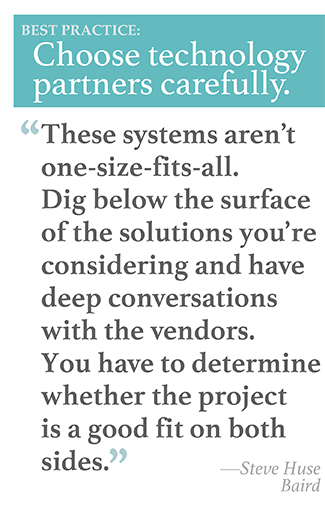
Baird is a full-service financial firm with more than US$200billion in assets under management and operations across the UnitedStates, Europe, and Asia. Despite the company's global reach, itsthree-person treasury team also handles accounts receivable. That'sa critical function for the client-focused business. Unfortunately,in 2016, receivables processes were largely manual, and staffsometimes had trouble keeping up.
|Every day, customers send hundreds of ACH payments and wiretransfers to fund their Baird investment accounts. “When thesepayments come in, we need to post those funds to their accounts assoon as possible,” explains Steve Huse, director of clientreporting at Baird. “We work in a real-time environment, with wirescoming in throughout the day. These payments are verytime-sensitive—they might meet a margin call or fund an imminentpurchase. Our financial advisers might be waiting for the funds tohit the customer's account so they can put that money to work inthe market.”
|To keep up, treasury staff would log onto their banks' portalsrepeatedly throughout the day and pull down BAI files containinginformation about incoming wires. “We would ask for payment data ina standard format,” Huse says. “Our institutional clients weretypically pretty good about complying, but our retail clients wouldsend information in all kinds of formats. The team would get boggeddown with trying to figure out how to properly apply payments tocustomer accounts and book them in the general ledger.” The leanteam was spending about half of a full-time equivalent (FTE)position on ensuring incoming electronic payments were bookedproperly.
|It's imperative that Baird book receivables both quickly andaccurately. “Through our online platform, customers see funds hittheir account same-day,” Huse says. “If something was keyedincorrectly, that mistake would be very visible. There was thepotential for a six- or seven-figure error because someone had fatfingers. And if we had to kick funds back to a client because wedidn't get proper information to apply the payment, that also wouldbe a client-service nightmare. Our business is predicated onexcellent customer service, so any issues around applying fundswould create a significant reputational risk for Baird.”
|When the company decided to deploy a new treasury managementsystem, automatic posting of electronic payments was front andcenter in the list of requirements. “We saw that bringing thatworkflow into the workstation could remove some of those points ofrisk,” Huse says. The company wanted to go with asoftware-as-a-service (SaaS) treasury system, both to reduce theburden on the internal IT team and to streamline upgrades to thesystem. “As a company, we've made a concerted effort to move towardSaaS-based solutions whenever those alternatives are available,”Huse says.
|The challenge was that Baird's desire for an automatedreceivables-posting process would require customization, somethingmany SaaS vendors shy away from. The treasury team launched theproject by collaborating with internal IT to determine how theposting process should be configured. “Our treasury analysts workedwith a system architect to whiteboard our preliminary thoughts onhow the system should work,” Huse says. “We invested a tremendousamount of time in determining what was and wasn't feasible.” Theyultimately came up with the idea of using an applicationprogramming interface (API) to connect the new treasury workstationto both the company's banking portals and its internal customerdatabase, for reconciling account information.
| Baird didn't find any SaaS-basedtreasury systems that provided these types of connections. However,a thorough due diligence process revealed that GTreasury wasinterested in accommodating the company's needs. The vendorprovided a proof of concept to demonstrate how the system couldwork, and Baird decided to move forward.
Baird didn't find any SaaS-basedtreasury systems that provided these types of connections. However,a thorough due diligence process revealed that GTreasury wasinterested in accommodating the company's needs. The vendorprovided a proof of concept to demonstrate how the system couldwork, and Baird decided to move forward.
GTreasury heavily customized the automated receivables-bookingprocesses in its system to accommodate the unpredictability ofinformation surrounding Baird's incoming payments. Now, when Bairdreceives a BAI file from a bank, the system uses a heavily modifiedtransaction assignment engine to parse through the file to findeach payment's associated Baird customer account number. “It startsby looking for an identifier like 'account' or 'reference' followedby the appropriate number of digits,” Huse says. “I think this typeof functionality is fairly common.”
|What's more unique is that when no identifier is clear, thecustomized workflows enable the system to continue searching forthe customer account number. “A BAI string might contain hundredsof number sequences that could possibly be a match,” Husecontinues. “An account number search might run right into phonenumbers or other strings, and there's no easy way for the system todetermine which digits make up the customer account number.”
|When the system encounters such a conundrum, it queries adatabase containing current Baird customer information. “The enginewill send all possible account numbers through an API call to thedatabase,” Huse says. “Assuming there's a match, it'll send amessage back to GTreasury with the portion of the string that is anaccurate account number. It can also do a secondary match withother information from the account record, such as last name.” Whenthe rules engine is confident it has the correct customer account,GTreasury automatically books the funds to the right account in thegeneral ledger (G/L).
|
See also:
- Webcast: Successful Treasury Transformation and Innovationthrough Technology Excellence
- Extending Visibility and Productivity for ExtendedPayment Terms
- Retooling Processes to Improve Productivity andROI
|
Around 90 percent of all receivables are now eligible forstraight-through processing. “The treasury team is responsible onlyfor dealing with exceptions now,” Huse says. “Most days, thosenumber between a half-dozen and a dozen.” This has greatly reducedthe amount of staff time required to deal with booking payments, sothe treasury team is better able to focus on strategicactivities.
|“We have more time to spend on value-added tasks like reportingand forecasting,” Huse explains. “We also now have more time tosupport our financial advisers and their clients when they have FX[foreign exchange]-related questions. And we can focus more onanalyzing the company's investment potential and intraday borrowingneeds.”
|He also credits the new processes with making Baird's businessmore scalable. “We went from about $178 billion in assets undermanagement in 2016 to around $211 billion today, and we haven'tadded headcount.”
|One more benefit is that the new workflows have reduced the riskof errors, in booking funds to the wrong customer's account or inthe wrong amount. “We've built a lot of controls andstandardization into our workflows,” Huse says. “Those are twotremendous benefits of any treasury management system.”
|Still, he says, finding the right vendor and working tocustomize the solution were crucial to the project's success.“These systems aren't one-size-fits-all,” Huse advises. “You needto dig below the surface of the solutions you're considering andhave deep conversations with the vendors. You have to determinewhether the project is a good fit on both sides.”
|Just as important, he adds, is finding a vendor that is willingto work to meet the company's unique treasury challenges. “Havingreally good collaboration with the vendor makes or breaks a projectlike this,” Huse adds. “It's very important to challenge the norms.Treasury needs to think creatively and partner with internalcolleagues and internal clients to come up with ideas for bettertreasury solutions, and then find a vendor that will help bringthose ideas to fruition.”
Complete your profile to continue reading and get FREE access to Treasury & Risk, part of your ALM digital membership.
Your access to unlimited Treasury & Risk content isn’t changing.
Once you are an ALM digital member, you’ll receive:
- Critical Treasury & Risk information including in-depth analysis of treasury and finance best practices, case studies with corporate innovators, informative newsletters, educational webcasts and videos, and resources from industry leaders.
- Exclusive discounts on ALM and Treasury & Risk events.
- Access to other award-winning ALM websites including PropertyCasualty360.com and Law.com.
*May exclude premium content
Already have an account? Sign In
© 2024 ALM Global, LLC, All Rights Reserved. Request academic re-use from www.copyright.com. All other uses, submit a request to [email protected]. For more information visit Asset & Logo Licensing.







